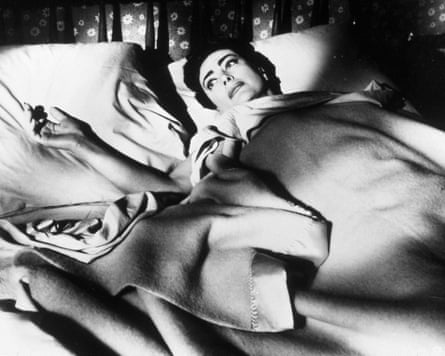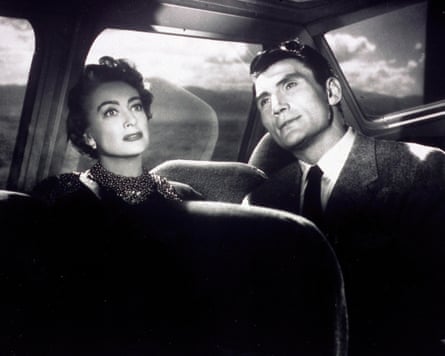“It’s the kind of a drama we used to call a thriller,” Joan Crawford said in a radio appearance in 1952, teasing an upcoming film. “In fact, it’s so exciting that the first time I read the script some friends rang my doorbell about 9 o’clock at night and I was afraid to open the door.” Imagine, for a second, a frightened Joan Crawford home alone, stirred up by the story that would soon become her next movie: Sudden Fear.
In the collective memory, Crawford is imagined with fear always in mind. Fear of being disliked or forgotten, fear of the box office, of bad lighting, even fear of wire hangers. The prevailing view of Crawford was that of the scary lady: frightening and frightened.
In 1943, after remaining under contract with MGM for 18 years, Crawford moved to Warner, the studio that would help her win her best actress Oscar for Mildred Pierce. But soon she became displeased with the roles available for a woman in her late 40s (her exact year of birth, even now, is still up for debate). Then came Sudden Fear, a film noir she took to competing studio RKO that once again won her Academy favour.
With Sudden Fear, Crawford forged an unprecedented Hollywood archetype: the now prevalent actress-turned-executive producer. She presided over the entire project, hired director David Miller, chose the screenwriter and cinematographer and personally selected co-stars Jack Palance and Gloria Grahame.

In Sudden Fear, Crawford plays Myra Hudson, a successful playwright and wealthy heiress lovestruck by a younger man. Sitting in on a rehearsal of her latest play, Myra decides that leading man Lester Blaine (Palance) must be recast. He “just doesn’t look romantic”, she says, and we’re inclined to agree. Like Crawford, Palance is a singular beauty: a skull rather than a face, craterous in black and white.
after newsletter promotion
By chance, the two meet again on a cross-country train to San Francisco. In close quarters, Myra is disarmed by Lester’s charms. She absolves him of her early judgments, and casts Lester as her romantic lead off-stage.
There’s a snag, however: Lester’s brassy lover Irene Neves, with whom he concocts a plot to murder Myra for her fortune. Mid-dinner party at Myra’s, Lester and Irene steal away to the host’s office voicing their plans – let slip only by the then-futuristic dictation machine accidentally recording them.
Of course, Myra ends up hearing the recording – and under the web of intrigue, there’s a tragic confession. “Love you?” Lester declares on the dictation machine. “I never loved you. Never for one moment.” In perfect melodrama, the camera never leaves Crawford’s face as she stumbles around the room reacting – or over-reacting. The filmmaker François Truffaut called her performance “a question of taste” – one that, I feel, should be acquired rather than challenged.

The disembodied voice, played back by the recording device, lends Crawford the chance to reprise her silent-film-star status once more: by 1929 she was one of very few to survive the transition from silents to talkies. The conversation she hears takes on a paranoid quality. Is this how people speak about me when I’m not around? As a filmmaking tool, the voice-over typically serves as an internal monologue, but here it’s terrorising: both absent and presently threatening. The voices come from elsewhere, estranged by time, and now they are lodged in Myra’s head!
Wide awake with conspiratorial voices keeping her up at night, Myra plans her counterattack, writing the rest of the script before it is written for her. She forges letters, breaks into Irene’s apartment, feigns sickness and dramatically falls down a flight of stairs to intercept her violent demise. It’s in these moments that Crawford’s own bias seeps into the text, and her attraction to Sudden Fear is exposed. Myra is a woman at the top of her game who chooses not to fold when she is undermined, instead taking back control and coming out the other side. Sounds like Joan Crawford to me.
Ten years after Sudden Fear and, at her nadir, Crawford would campaign for the novel What Ever Happened to Baby Jane? to be adapted as a motion picture, starring herself alongside – nay, underneath – twin flame Bette Davis. The film cemented their conjoined cult status and spawned a whole new subgenre: hagsploitation. If What Ever Happened to Baby Jane? was the story of industry roadkill, then Sudden Fear was Crawford in the driver’s seat of her own star vehicle.
-
No Way Out is streaming on Tubi in Australia and available to rent in the UK and the US. For more recommendations of what to stream in Australia, click here

.png) 3 months ago
123
3 months ago
123

















































